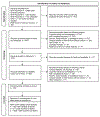The stability of cognitive abilities: A meta-analytic review of longitudinal studies
- PMID: 38330347
- PMCID: PMC11626988
- DOI: 10.1037/bul0000425
The stability of cognitive abilities: A meta-analytic review of longitudinal studies
Abstract
Cognitive abilities, including general intelligence and domain-specific abilities such as fluid reasoning, comprehension knowledge, working memory capacity, and processing speed, are regarded as some of the most stable psychological traits, yet there exist no large-scale systematic efforts to document the specific patterns by which their rank-order stability changes over age and time interval, or how their stability differs across abilities, tests, and populations. Determining the conditions under which cognitive abilities exhibit high or low degrees of stability is critical not just to theory development but to applied contexts in which cognitive assessments guide decisions regarding treatment and intervention decisions with lasting consequences for individuals. In order to supplement this important area of research, we present a meta-analysis of longitudinal studies investigating the stability of cognitive abilities. The meta-analysis relied on data from 205 longitudinal studies that involved a total of 87,408 participants, resulting in 1,288 test-retest correlation coefficients among manifest variables. For an age of 20 years and a test-retest interval of 5 years, we found a mean rank-order stability of ρ = .76. The effect of mean sample age on stability was best described by a negative exponential function, with low stability in preschool children, rapid increases in stability in childhood, and consistently high stability from late adolescence to late adulthood. This same functional form continued to best describe age trends in stability after adjusting for test reliability. Stability declined with increasing test-retest interval. This decrease flattened out from an interval of approximately 5 years onward. According to the age and interval moderation models, minimum stability sufficient for individual-level diagnostic decisions (rtt = .80) can only be expected over the age of 7 and for short time intervals in children. In adults, stability levels meeting this criterion are obtained for over 5 years. (PsycInfo Database Record (c) 2024 APA, all rights reserved).
Figures








References
-
- *Adkins DC (1937). The efficiency of certain intelligence tests in predicting scholarship scores. Journal of Educational Psychology, 28(2), 129–134. 10.1037/h0058951 - DOI
-
- *Allan ME, & Young FM (1943). The constancy of the intelligence quotient as indicated by retests of 130 children. Journal of Applied Psychology, 27(1), 41–60. 10.1037/h0054264 - DOI
-
- *Allen MM (1945). Relationship between the indices of intelligence derived from the Kuhlmann-Anderson intelligence tests for grade I and the same tests for grade IV. Journal of Educational Psychology, 36(4), 252–256. 10.1037/h0058184 - DOI
-
- *Arthur W Jr, Glaze RM, Villado AJ, & Taylor JE (2010). The magnitude and extent of cheating and response distortion effects on unproctored internet-based tests of cognitive ability and personality. International Journal of Selection and Assessment, 18(1), 1–16. 10.1111/j.1468-2389.2010.00476.x - DOI
Publication types
MeSH terms
Grants and funding
LinkOut - more resources
Full Text Sources

